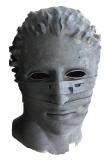Results 1 to 8 of 8
Thread: Printing tiny things
-
01-04-2016, 06:09 PM #1Student

- Join Date
- Jan 2016
- Posts
- 2
Difference between CAD and print (printing tiny things)
Hi all
I have a problem with printing tiny objects and need an advise on how to fix this.
Here's the thing:
After some tries I did a test print to check if my printer is even able to print small things. I made a cube with holes from 2-5mm in diameter in it. The 2mm hole has only 1.4mm, the 3mm hole ends up being 2.53mm. Only staring from 5mm the holes look fine. Can anyone tell me how to solve this issue?
Since I'm new to 3d printing any advise will probably help.
Slicing software: Simplify3D
Printer: Prusa i3
Firmware: Marlin
Filament: PLA 1.75mm
Print-Temperature: tested 190-210°C
Nozzle: 0.4mmLast edited by nurbs999; 01-05-2016 at 07:25 AM.
-
01-04-2016, 08:14 PM #2
Pretty much, RepRap's do not make the holes as big as they are specified in the CAD design. It has always been that way. They need to be specified a little bit bigger than what you really want. And to make matters worse, if you get the hole size right on one printer, it won't be right on the next printer.
-
01-05-2016, 06:52 AM #3Student

- Join Date
- Jan 2016
- Posts
- 2
Thats the last thing I wanted to read
 Thanks for the info Roxy
Thanks for the info Roxy
Is it the same thing with "big" objects? I also printed a case that should be 156mm width and the print ended up in being only 146mm though all calibration cubes are the size they should be (20mm in CAD are 20mm in the printed object).
-
01-05-2016, 07:05 PM #4
Bigger holes have less of an impact. What is happening is the filament is arcing as it goes around the circle and the inside part of the filament doesn't really have enough room because it is being laid down in a circle. There is something else wrong if 156mm is turning into 146mm.
-
01-06-2016, 07:11 AM #5
There are a series of analysis and explanations on the hydraraptor blog : he investigated that in 2011. Some of the parameters can't be corrected as they are process induced (arc shrinkage) and others are not practical to correct (the cosPi/n correction) so the bottom line (for me !) was to set the diameter I wanted and re-drill after because the general conclusion is that the printed hole will always be smaller than the intended cylinder.
-
01-06-2016, 08:02 AM #6
nurbs999: Check out these links that LambdaFF is talking about. I didn't recognize the name hydraraptor, but this blog appears to be written by NopHead. NopHead REALLY knows his stuff!!!
http://hydraraptor.blogspot.com/2011...flow-rate.html
http://hydraraptor.blogspot.com/2011/02/polyholes.html
-
01-06-2016, 08:24 AM #7
I agree with Roxy that there's another problem if the large case was wrong. I'd solve that problem first.
Did you adjust your steps per mm to get the 20mm cube dimension right? If so, go back to the original setting. X, Y and Z steps per mm are defined by the design of the hardware and generally shouldn't be adjusted through a calibration. When the steps per mm are tweaked to get the 20mm (or any other single calibration print exactly right), you can be left with a printer that can *only* print the calibration dimension correctly, with everything else off by some percentage. Search for prusa calculator if you don't know or want to double check the steps per mm settings for those axes.
Configuring the slicer to print external perimeters first might help a bit on the holes. That will cause the exposed wall of the hole to be printed first, and other perimeter walls then added around that. Otherwise like Roxy said the exposed wall will be pushed towards the center of the hole a bit more when it prints against the perimeters that are already there.
I've found printing holes on the bottom of things using a heated bed and PLA filament is especially troublesome since the PLA material stays soft sometimes for several layers of a print. Adding new layers on top of still soft layers will rarely lead to good prints. Adding a good print cooling system for PLA helps "freeze" the filament quicker and help it retain it's shape.
Finally, it may be specific to openSCAD, but search on polyhole to see one design approach of improving resulting sizes of small holes. Printing PLA and the polyhole library function in openSCAD, I now do pretty good in having things like M3 to M5 holes come out right, using standard tap & clearance dimension tables for proper dimensions on clearance holes, holes for self-threading, etc. But I still have an assortment of deburring tools, small files, and drill bits to clean up anything that needs some final adjustment.
EDIT: A bit of a correction. In double-checking the hole dimensioning I used in my refinement of the greg's wade extruder suite, I see in that openSCAD design I did add 0.2 to 0.3mm to what a mechanical craftsman would use for a clearance hole. Still not bad for a fudge. In the openSCAD source for the refined greg's wade, I include a table in the contents showing what standard hole sizing would be. I copy that table into many of my openSCAD designs as a handy reference. In that file, I also provide the option to generate a plate for testing the hole sizes before bothering with a full formal print of the parts. I wish more people offered that in their designs.Last edited by printbus; 01-06-2016 at 10:09 AM.
-
01-06-2016, 08:26 AM #8




 Reply With Quote
Reply With Quote









QIDI Slicer "Plater" is...
04-12-2024, 02:21 AM in QiDi 3D Printer Forum